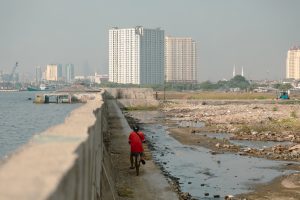Once a blessing, water is now a perpetual curse.
Smothered in concrete and with a dearth of green spaces, greater Bangkok, Jakarta, and Ho Chi Minh City hold their collective breath every monsoon season. In Southeast Asia’s over-urbanized megacities, there is often little warning for residents before havoc breaks out: Within a couple of hours, large swathes of land are quickly inundated as lackluster drainage systems are rapidly overwhelmed, becoming like giant bathtubs.
Despite people’s best efforts to slow down the onslaught of water with sandbags, emergency pumping stations, and temporary barriers, they are of little help as storm surges from the nearby seas leave the water nowhere to go. Everyone knows about it, but no one knows what to do.
Water has always been the driving force in the development of these cities. Built on the foundation of vital waterways by a combination of rain, rivers, and the sea, the Chao Phraya Delta (Bangkok), Mekong Delta (Ho Chi Minh City), and Ciliwung Delta (Jakarta) are at great future risk for permanent, massive land losses in the next few decades.
These Asian cities are water-stressed in two ways: They fight the encroaching sea and struggle to provide sufficient potable water to their booming populations. During a storm, water is a multi-vector threat for flood-prone deltas: It overflows from connected rivers, heavy rainfall, and from the sea. The aftermath is devastating as countless lives and homes are lost; the economic toll is enormous and long-lasting. After severe flooding events, some are temporarily displaced and others are permanently pushed out. The outlook is also much worse than predicted three decades ago for numerous coastal cities, many in Asia.
Like many of Asia’s powerhouses built at the sea’s edge, Bangkok, Ho Chi Minh City, and Jakarta continue to face a mutually risky future: They are sinking while they continue to rapidly urbanize and grow. Heavy building infrastructure is an additional key factor that exacerbates this process. The economic importance of these cities is immense. Bangkok and Jakarta account for roughly half their countries’ total economic output and Ho Chi Minh City for 25 percent of Vietnam’s.
The effects of climate change will leave desperate farmers from Asia’s deltas no choice but to abandon their fields and join their countrymen in the pursuit of urban life, exacerbating the already severe internal migration situation in these three cramped cities. Saltwater intrusion ruins already fragile agricultural and drinking water supplies and puts even deeper strains on cities by forcing people to move to areas that are still not connected to piped water sources.

































